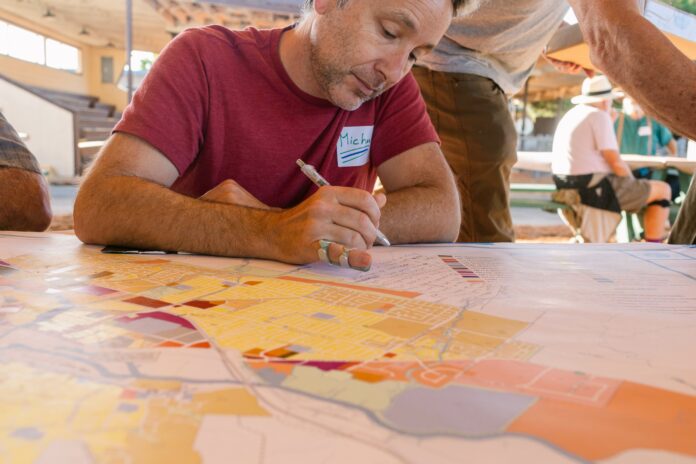Last Friday I sat down with a couple of hundred other bright-eyed optimists at Petaluma’s much-loved Sonoma Marin Fairgrounds to talk about “the creation of strong, vibrant and connected neighborhoods.”
The event was part of the Sustainable Design Assessment Team grant from the American Institute of Architects. The goal of the project, known as Localuma, was put most simply by AIA team-lead Mike Davis: “We’re gonna try to get our arms around what having Petaluma be a 15-minute walkable city looks like.”
The idea behind this type of walkable city is the 15-minute neighborhood. Such a city is designed around neighborhood hubs that include retail, grocery, parks and other basic needs that, too often, people have to jump in their car and drive to reach. An example of such a hub in Petaluma that was noted by the team is Leghorn shopping center on the northeast side of town.
Dozens of volunteers from the community organized the application and hosted the Friday night dinner, where participants were asked how they would like to see the city transformed to meet carbon-neutrality goals.
In addition to the community gathering and other stakeholder events over the weekend, there was specific direct outreach to the Latinx community. Getting participation from the Latinx community has long been a goal for local sustainability activists, and one that has not yet been successfully attained.
The SDAT team took the time to build relationships with Spanish-speaking leaders and then, when the AIA consultants were here in town, by going to the Spanish-speaking community where they are … in this case to St. Vincent’s Catholic Church’s Spanish mass, and to Lolita’s Market on Lakeville.
Speaking about this novel approach, Iliana Madrigal-Hooper said, “It is something different I haven’t seen before. I have been telling all these nonprofit organizations, ‘If you want the Latino community to participate, [then] you have to go to the laundromat, you have to go to Lolita’s Market, there are a few key places in Petaluma that you have to show up. You have to be persistent.’” It is a credit to the SDAT team that they established a connection to the Latinx community here in town in a way not attempted before.
Another concern that was raised in conversations on Friday was the ever-present danger of overlap of activities with similar activist initiatives. Indeed, among the volunteers were local climate action leaders from Cool Petaluma, Daily Acts, 350 Petaluma and many more, all groups that have run their own similar activities, possibly running the risk of diluting their efforts.
SDAT committee co-chair Veronica Olsen agreed that there is a history of this problem. “We’re all guilty of being in our little zones,” she said, “and we don’t always look at how everything is impacting everything else.”
Natasha Juliana, Cool Petaluma’s campaign director, assured me that in her organization’s case there was an “intentional synergy” with SDAT’s work. The block-by-cool-block initiative will use the SDAT findings “to create a second phase going beyond the block program,” making changes on the neighborhood level.
According to SDAT’s findings, as presented to the city council, these changes could look like tree-lined major arterials, mini-downtowns throughout the cit, and interconnected green corridors, allowing for easy and inviting biking and walking throughout our fair city.











